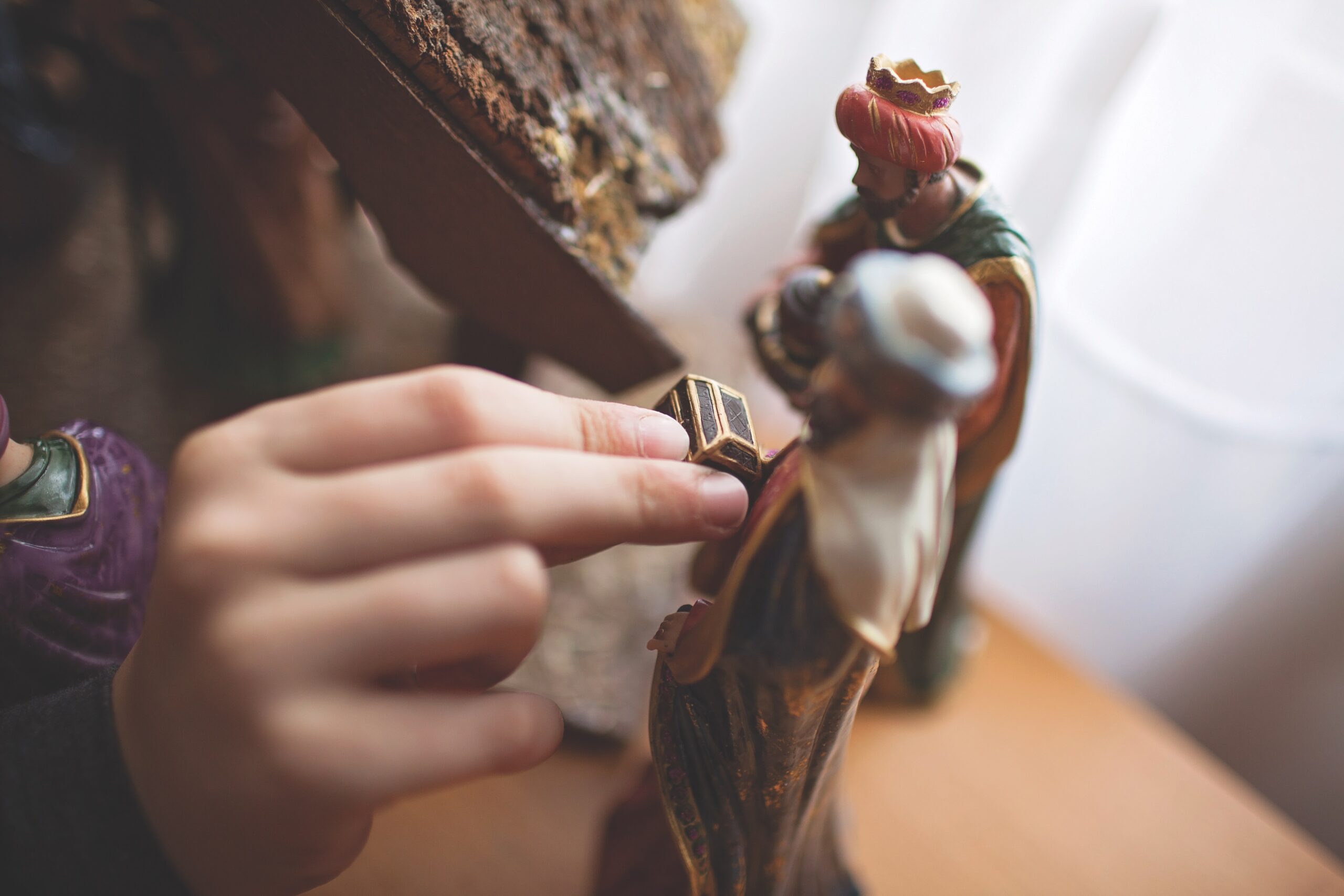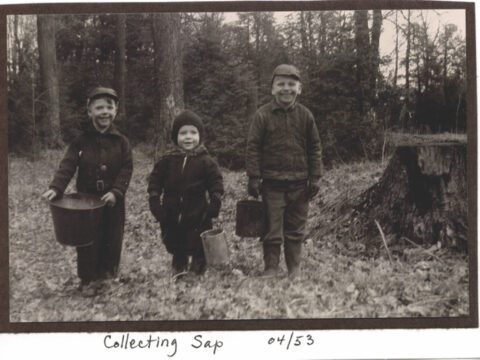Rev. Paul Shepherd remembers helping his four-year-old son, Gareth, fashion a homemade stable out of a wooden box that once held oranges. After arranging the nativity figures, inherited from Shepherd’s grandparents, inside the crèche, Gareth had an ingenious idea: he tore a 12-foot piece of white masking tape from the roll, laid it across the living-room carpet and marked 24 lines on the tape that led to the nativity scene. Each day leading up to Christmas, Gareth and his brother, Ian, would advance the magi one mark closer to the manger under the Christmas tree.
The story of the wise men’s long journey across a vast desert with only a single star to guide them obviously left a deep impression on Gareth’s imagination. “It was all his idea. He loved playing with the figures, and he found a wonderful way to express the anticipation of waiting for Christmas,” says Shepherd, who serves Wesley Mimico United in Toronto.
Such is the allure of the crèche that we can’t keep our hands off it. Shepherd knows this from personal experience. When he was a boy, he and his two brothers would find creative new locations for the nativity figures, once even plunging them into a bed of stones at the bottom of a fish tank. “My mother was not impressed,” he says. “But to me, it was a very real way to be engaged in this mythical story.”
Maybe that’s why Shepherd was unperturbed when the large outdoor wooden crèche at his church was vandalized a couple of years ago. “It looked like kids had simply moved some of the characters in the story around — in particular, they laid the shepherds down as if putting them to sleep.” Members of the congregation were upset; someone suggested installing a security camera.
In his sermon the following Sunday, Shepherd urged them to reconsider. “Is the nativity story — and our crèche — something that we want to keep in some preserved state, safely locked away, or is it something that we want the community to engage with in a meaningful way?” he asked. He suggested erecting a sign to encourage people to move the figures “in respectful ways to allow them to tell the story in their own way.”
Alas, it was not to be. The following week, a vandal cut off Mary’s nose and broke Joseph’s arm, and a security camera was installed.
The crèche — among the most popular Christian symbols — refers to the feeding trough for animals in which Mary placed Jesus after his birth. But for Christians around the world, it’s a venerable holiday tableau that serves to enchant the imagination, revive childhood memories and, yes, sometimes invite negative attention.
Crèches are captivating because they bring together faith and art, represent a timeless tradition and reflect a wide diversity of cultures. There are ebony crèches from Africa, German figures carved in wood, Mexican Josephs dressed in ponchos, and Inuit baby Jesuses swaddled in rabbit fur and lying on sleds. Each one emerges at Advent from a musty storage box, the figures lovingly freed from their tissue-paper wrappings and displayed under the tree or on the mantle. All of them tell of the unfolding mystery of the nativity, the revelation of Jesus’ humanity in the image of a squirming baby.
“There’s a feeling of love that is expressed in the crèche,” says Nancy Mallett, a member of the international Friends of the Crèche association and the archivist at Toronto’s St. James Anglican cathedral, which hosts an annual exhibit of some 200 crèches every year.
Recreating the scene of Jesus’ birth has transfixed us for centuries, ever since St. Francis of Assisi presented a dramatic staging of the nativity with real people and animals during a 1223 Christmas Eve mass in Greccio, Italy. Elaborate static manger scenes caught on in Italian churches, then smaller versions, fashioned by artisans out of wax and wood with the figures dressed in fine fabrics, began appearing in the homes of the wealthy. Today, 800 years after St. Francis’s theatrical debut, you can walk into a Toys “R” Us and pick up a made-in-China plastic Fisher-Price “Little People” nativity set for a mere $39.99.
No doubt about it — Christians are crazy for the crèche. There are hard-core collectors who own hundreds of crèches and scour the world in search of unusual sets. There are crèche newsletters, conventions and European crèche travel tours. The styles range from the sublime to the sentimental to the silly — consider, for example, a Cape Cod crèche that features Mary as a mermaid, Joseph brandishing a trident, the baby Jesus covered with a striped beach towel and wise men consisting of a crab, a crocodile and a horse.
It gets even more ridiculous: Christian author Mark Oestreicher of San Diego has collected 50 of the “worst and weirdest” nativities on his blog, WhyIsMarko.com, including many that are edible (and therefore downright tacky), such as a crèche made of bacon and sausage and another made of marshmallows. He doesn’t exactly celebrate these creations, viewing them instead as “whimsical attempts for people to engage in a mystery.”
Sometimes engagement with the crèche has negative outcomes. Joseph figurines frequently go missing, likely because he’s the patron saint of home. According to Catholic lore, burying his statue in the yard promises a quick sale on a house. Vandalism of church crèches is also widespread, and the babe in the manger is the most common victim. “Stolen baby Jesus” is an actual Wikipedia entry. There’s even a company that sells a GPS tracker for high-tech protection of nativity figures.
Despite the risks, museums, churches and even entire communities continue to stage massive crèche displays. The Church of Jesus Christ of Latter-Day Saints in Walkerton, Ont., for example, has exhibited the largest interfaith display of crèches in the world, with more than 3,000 nativities from 165 area churches and hundreds of individuals. Organizer Flora Nabrotzky says the idea came to her in a dream.
“When it came time to set up the display, it was as easy as doing a paint-by-number — God was the designer, and I simply matched it up with the vision He gave me.” Nabrotzky took on the massive project for eight years running (it’s currently on hiatus) because “there’s a lot of suffering in the world, and we need the light of our Saviour.”
A few years ago, 150 people in Creemore, Ont., created an impressive community crèche on the snow-covered grounds of St. Luke’s Anglican Church. Diane Hutchings, an artist and St. Luke’s member, was the driving force behind the display. She had children draw pictures of actual townsfolk, from the local newspaper editor to the server in the coffee shop, as well as local wildlife such as skunks, rabbits and deer. Craftspeople then transferred these images onto 30 life-size wooden characters. Each morning in the days leading up to Christmas, a character was erected on the lawn, and each day they were all moved a little closer to the manger that sat outside a teepee under a cedar tree. On Christmas morning, Jesus was placed in the manger. Says Hutchings, “It was really magical. It brought the people of our village together.”
But nothing beats the efforts of the people of Rivière-Éternité, a picturesque village of 500 in Quebec’s Saguenay region that’s known as the “Village of the Crèche” or “Modern Bethlehem.” The village hosts an annual international exhibition of hundreds of nativity scenes, about 150 of which are installed outdoors. Some 25 life-size crèches are displayed in the centre of town, and a six-metre crèche perches on a mountainside, accessible by a path.
“It’s one of the most beautiful places I’ve ever been,” says Catherine Limbertie, a former executive director of the Toronto Community Folk Art Council who wrote a paper about the town.
Public nativity scenes, however, can also generate controversy — particularly when displayed on government property. A few years ago, the Montreal suburb of Mount Royal removed a nativity scene from its town hall rather than acquiesce to a request from a Muslim group to erect Islamic religious symbols.
And there have been numerous lawsuits in the United States challenging the Supreme Court’s 1985 ruling that nativity scenes on public lands violate the separation of church and state unless they comply with the so-called reindeer rule, which calls for equal opportunity for non-religious symbols to avoid any hint that the state is endorsing religion. Commenting on this law, late-night TV comedian Jay Leno quipped, “The Supreme Court has ruled that they cannot have a nativity scene in Washington, D.C. This wasn’t for any religious reasons. They couldn’t find three wise men and a virgin.”
Jokes aside, at different points in history, displaying a nativity scene has been dangerous. Crèches were banned during both the French and Russian revolutions. In the 17th century, the English Puritans outlawed Christmas decorations, including the crèche, and even passed legislation against the English tradition of baking a mince pie in the shape of a manger to hold the Christ child until dinnertime, when the pie was eaten.
Later, when the Nazis tried to ban crèches, people hid them under their floorboards, says Mallett, the archivist at St. James Cathedral. Prisoners of war have fashioned crèches out of whatever objects they could cobble together, making simple nativities from tree branches and buttons. “They wanted to keep the story alive, even if they might have been killed if they were found out,” she says.
Keeping the story alive is certainly a motivation for many who display a crèche at Christmas, even those who believe the story is just a beautiful and enduring myth with elements of sacred truth. Christ’s birth is noted in only two of the Gospels (Matthew and Luke); there is a manger, but no stable, animals, innkeeper, singing angels or drummer boy. The magi appear only in Matthew, and it’s unlikely they visited Jesus until he was a toddler. Luke makes no reference to a special shining star.
Rev. Steve Willey is the program co-ordinator of education and leadership development at the United Church’s General Council Office. He has written an online resource about the significance of the intercultural crèche and says it’s important to consider who isn’t represented in the nativity scene. “Certainly a midwife would have been there, for example.”
While crèches may not jibe with the scriptural record, it’s the spirit of the story that matters to Willey. The nativity scene is “like a vision that has blurred edges,” he says. “It dwells in the same category as Jesus’ transfiguration or Moses’ burning bush. It’s a hopeful vision that allows us to move toward a future that is ordained by God.”
And this hopeful vision includes many things close to the heart: the miracle of birth; the comfort of the family unit as represented by Mary, Joseph and the baby; the power of community symbolized in the attending shepherds, angels and wise men; finding the divine in the commonplace; the promise of a new year and a fresh start.
“The familiar Christmas crèche is a lens that helps us to see God’s vision for the world,” writes Willey. “[It] evokes Eden before the fall. Bethlehem witnesses a moment of paradise regained where all God’s creatures dwell in harmony.” No wonder we find the crèche so compelling. “Its enduring fascination and appeal speaks to something inside of us, something deep in our spirit,” Willey says.
***
This story first appeared in The United Church Observer’s December 2014 issue with the title “Away in a manger.”















